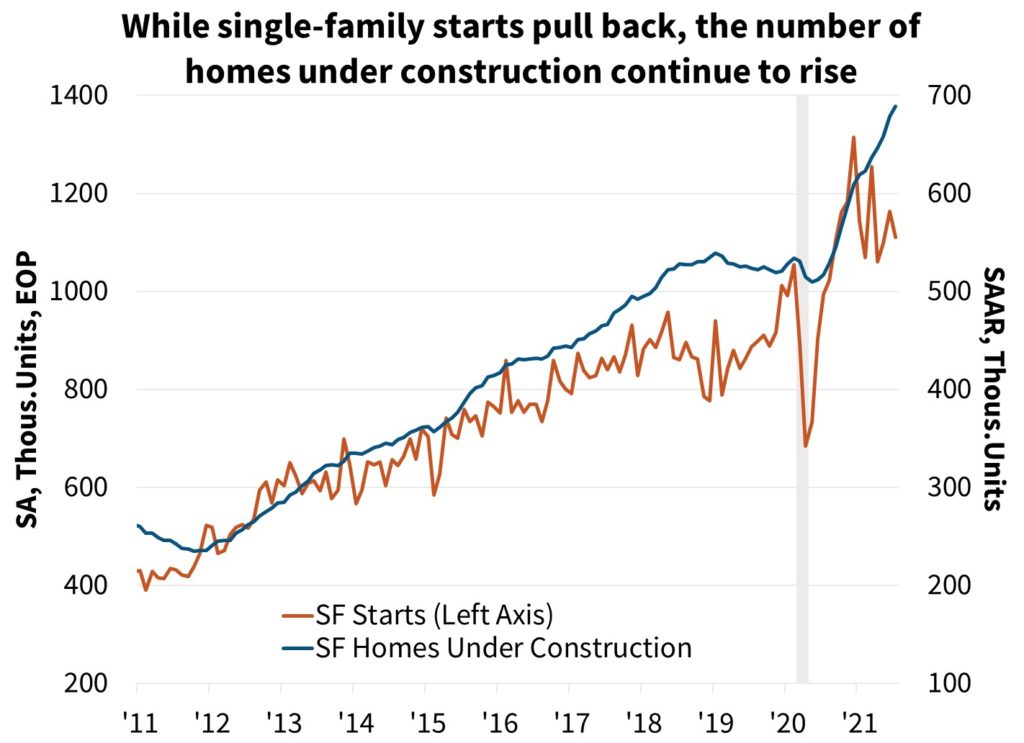
Supply and Labor Constraints Continue to Hinder Economic Growth, Home Sales
For the second month in a row expectations for near-term real GDP growth were revised downward – and outward – due to persistent supply chain disruptions and labor market tightness, according to the September 2021 commentary from the Fannie Mae (OTCQB: FNMA) Economic and Strategic Research (ESR) Group. The ESR Group now projects full-year 2021 real GDP growth to clock in at 5.4 percent, down from its previous forecast of 6.3 percent, anticipating instead that much of the previously projected second-half 2021 growth will take place in 2022, for which it upgraded its economic growth forecast from 3.2 percent to 3.8 percent. Inflation continues to be a key concern, as well, with the ESR Group forecasting the Consumer Price Index to end the year at an annualized pace of 5.4 percent and remain above 5 percent until the second quarter of 2022. The pulling back of recent transitory inflation drivers, such as the surge in used auto prices, is expected to be partially offset by longer-lasting wage and housing-related pressures. Principal risks to the forecast include the ongoing behavioral response of consumers to COVID developments, the duration of labor scarcity and supply chain constraints, and policymakers’ fiscal and monetary actions.
Supply constraints also continue to impede the housing market. While existing home sales recently came in stronger than expected, other indicators of home sales activity, including purchase mortgage applications and pending home sales, point to near-term softening. However, the lack of inventory of homes for sale continues to be the primary impediment, with the months’ supply of inventory near historical lows and the pace of new listings too low to sustain the current sales pace. Home construction is also being held back by supply problems, and as such the ESR Group downgraded its expectations for fourth quarter new home sales from 846,000 units to 789,000 units. The forecast for purchase mortgage originations was little changed for 2021 but now envisions a 6.3% increase for 2022; meanwhile, refinance origination volumes are expected to decline from a 58 percent share of total mortgage origination activity to 40 percent in 2022.
“Economic growth continues to be held back by supply chain and labor market constraints, both of which we expect to continue well into 2022,” said Doug Duncan, Fannie Mae Senior Vice President and Chief Economist. “We also expect inflation to remain elevated through much of next year, even if the crest of the recent surge is behind us. Given the strength of recent house price appreciation and rent growth, we continue to believe that the contribution from housing to underlying inflation has yet to be fully realized within the official measures of inflation. Further, affordability remains a challenge, even with mortgage rates near historic lows; if the pace of income growth doesn’t keep up with inflation and interest rates rise more than expected, we’d expect housing activity to slow from our current projections.”
Visit the Economic & Strategic Research site at fanniemae.com to read the full September 2021 Economic Outlook, including the Economic Developments Commentary, Economic Forecast, Housing Forecast, and Multifamily Market Commentary. To receive e-mail updates with other housing market research from Fannie Mae’s Economic & Strategic Research Group, please click here.






